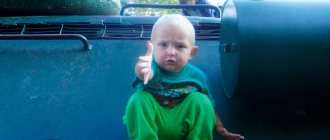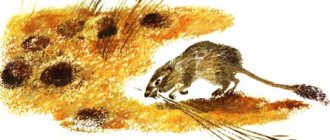Seas and oceans are the cradle of life on Earth. According to some theories, all life on the planet originated in water. The sea resembles a huge metropolis, where everything lives according to its own laws, everyone takes their place and performs a very important function. If this order, which has developed into a harmonious mosaic, is disrupted, then this city will cease to exist. Therefore, it is important to know about the riches of the animal world. You can find out who these marine inhabitants are, photos with the names of the most common species and interesting facts about their life.
All living creatures inhabiting the sea are divided into several categories:
- animals (mammals);
- fish;
- algae and plankton;
- deep-sea fauna;
- snakes and turtles.
There are animals that are difficult to classify into a specific group. For example, sponges or sponges.
Under the water

In the underwater world, everything is different from what we have on earth.
You need to move there not standing, but lying down. It is very difficult to walk there, but easy to fly. And you can even jump upside down there.
Arms and legs in this world become a third shorter, and fish, shells and algae become a third longer than their height. Water flattens distances and enlarges objects.
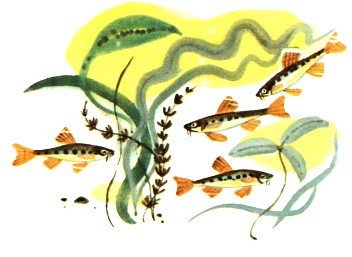
There is never rain or snow in the underwater world. There are not stars or clouds in the sky, but waves. Air bubbles roll between the waves - shiny, like stars!
In winter it’s not white, but black: it’s an impenetrable night all winter.
There is no horizon - the line where the earth meets the sky.
There are no cheerful sunbeams galloping across the land of the underwater world. Wide ribbons of sunlight sway there - reflections of the waves and the sun. Purple shadows from red bushes lie on the unsteady gray ground. A soft green haze covered everything around - there are no sharp shadows or sharp corners.
Everything is wrong, illusory and mysterious.
Everything is not the same as here on earth.
* * *
I could hardly wait for summer: I was so impatient to go under the water and see the fish.
Our lake fish are not a curiosity. Ruffs, roaches, perches, pikes - who hasn’t held them in their hands?
But it’s one thing to have a fish in your hand, and another thing to have it in the water. The fish is at home in the water, that’s where it lives. And the fish in your hand collapses and dies.
A dead fish even has a lifeless, faded color.
Fishermen say that dead fish wither.
Or maybe the fish are alive! Bright, fast, frisky.
Who doesn’t want to look at these!
I put a diving mask on my face.
He put his feet into rubber fins.
I began to look like a one-eyed frog. And, like a frog, he dived into the water.
Algae and plankton
This is the most numerous form of life. There are two types of plankton:
- Phytoplankton. It feeds by photosynthesis. Basically it's algae.
- Zooplankton (tiny animals and fish larvae). Eats phytoplankton.
Plankton includes algae, bacteria, protozoa, crustacean larvae, and jellyfish.
Jellyfish are one of the oldest creatures on Earth. Their exact species composition is unknown. One of the largest representatives is the Lion's Mane jellyfish (tentacle length 30 m). The “Australian wasp” is especially dangerous. Transparent jellyfish are small in size - about 2.5 cm. When a jellyfish dies, its tentacles can sting for several more days.
Fifth name
Roaches are just like swallows: slender, fast, restless. But they don’t look like swallows in color.
In the water, roaches appear gray, and fishermen sometimes call them seryanki for this. Or rudds - for their red fins.
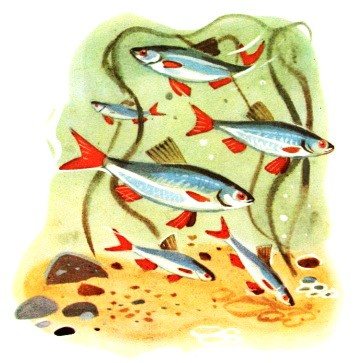
Roaches are always on the move. Either they dart like gray shadows between the algae, or they suddenly shoot up and flash like sunbeams. Because of this shine, the roach is also called the silver roach.
The roach also has one more name - the fourth. Somehow I made my way through the thickets and swam out into an underwater clearing. The clearing is empty. Some bubbles, like white moths, flew up.
And suddenly red sparks swirled around me!
I even shuddered - my eyes!
Red, shiny, like lights.
You can’t swim past such eyes, you’ll stop: not eyes, but real brake lights!
Because of its red eyes, many fishermen call the roach red-eyed.
How many names does the roach have: seryanka, rudd, silverfish, red-eye! And everyone is good.
But if it were up to me, I would give the roaches a fifth name - water swallow. They are very playful and dexterous. And the tail is like a swallow’s, with a fork.
Underwater urchins
In the ruff, as in the hedgehog, the most noticeable thing is the spines.
Head, tail, spines in the middle - that's the whole ruff.
And also the eyes: lilac-blue, large, like a frog’s.
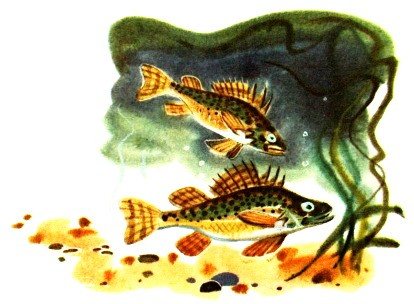
Ruff is as tall as a little finger. And if it’s the size of an index finger, then he’s already a ruff old man.
These old men scared me. I swim and see: the bottom is moving! It stirred and stared at me with points of dark eyes.
These are ruffs - old man to old man! They themselves are invisible: tails, heads, spines - everything is as spotted as the bottom. Only eyes are visible. I hung over the ruffs, my fins dangling.
The ruffs became wary. The timid ones suddenly began to fall to the bottom, bend over and deliberately raise clouds of turbidity.
And the angry and brave ruffled the thorns on their humps - don’t come near them!
Like a hawk above the sparrows, I began to circle over the flock of ruff.
The ruffs waited.
I began to wheeze into the breathing tube.
The ruffs were not afraid.
I widened my eyes - at least they didn’t care!
Then I... almost said: “I spat on the ruffs”... No, I didn’t spit, you can’t spit under water, but I waved my flipper at the ruffs and swam away.
No such luck!
A sharp swing of the fin caused mud to rise and swirl from the bottom. All the ruffs rushed to her: after all, delicious worms and larvae rose from the bottom along with the mud!
The faster I worked with my fins, in a hurry to swim away, the more silt I lifted from the bottom.
Clouds of silt swirled behind me like dark storm clouds. Behind the clouds were flocks of ruffs.
The ruffs only lagged behind when I swam to the depths. But at the depths I felt uneasy. I was not yet accustomed to the depth - these were still my first steps under water.
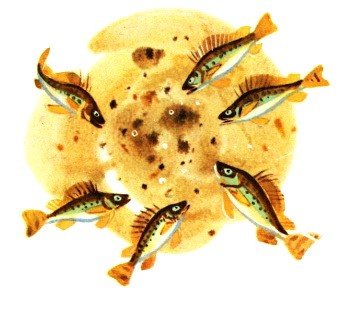
The bottom sank deeper and deeper. And it seemed to me that I was flying above the ground and soaring higher and higher. I just wanted to grab onto something so as not to fall from such a height!
I turned back.
It's overgrown again. There are ruffs in the thickets. It seems more fun: all living souls!
Little fingered ruffs swim in the middle of the water, and old men swim at the bottom. Now I deliberately raised the mud with my flippers. “Old men” and “little fingers,” like sparrows on millet, rushed at her.
I no longer scare the ruffs: I don’t wheeze into the phone, I don’t stare at them.
Just looking.
And therefore, even the most timid no longer fall on their sides to pick up the mud from the bottom and hide in it. And the angriest ones don’t have thorns on their humps.
Flexible guys. The spines in the ruffs, although the most noticeable thing, are not the most important thing!
The most popular types of sea fish
The second largest group of marine inhabitants includes the following species:
- Cod (blue whiting, cod, navaga, hake, pollock, pollock and others).
- Mackerel (mackerel, tuna, mackerel and other fish).
- Flounder (flounder, halibut, dexist, embassicht, etc.).
- Herring (Atlantic menhaden, Atlantic herring, Baltic herring, Pacific herring, European sardine, European sprat).
- Garfish (garfish, medaka, saury, etc.).
- Sea sharks.
The first species lives in the seas of the Atlantic Ocean, comfortable conditions for them are 0 ˚ C. Its main external difference is the mustache on its chin. They live mainly on the bottom, feeding on plankton, but there are also predatory species. Cod is the most numerous representative of this subspecies. It reproduces in large numbers - about 9 million eggs per spawning. It is of great commercial importance, since meat and liver have a high fat content. Pollock is a long-lived member of the cod family (lives 16 - 20 years). It lives in cold waters and is a semi-deep-sea fish. Pollock is caught everywhere.
Mackerels do not lead a bottom-dwelling lifestyle. Their meat is valued for its high nutritional value, fat content and a large amount of vitamins.
In flounders, the eyes are located on one side of the head: right or left. They have symmetrical fins and a flattened body.
Herring fish are pioneers among commercial fish. Distinctive features are no or very small teeth, and almost all lack scales.
Sargan-like fish are elongated in shape with long, sometimes asymmetrical jaws.
The shark is one of the largest marine predators. The whale shark is the only one that feeds on plankton. The unique abilities of sharks are smell and hearing. They can smell a smell from several hundred kilometers away, and their inner ear is capable of detecting ultrasound. The shark's powerful weapon is its sharp teeth, with which it tears the victim's body into pieces. One of the main misconceptions is the idea that all sharks are dangerous to humans. Only 4 species pose a danger to people - bull shark, white shark, tiger shark, and whitetip shark.
Moray eels are marine predators from the eel family, whose bodies are covered with poisonous mucus. Outwardly they are very similar to snakes. They practically cannot see, they navigate in space by smell.
Fish kids
Light and fun underwater on a sunny day!
Especially in shallow water. There, in sandy clearings, long and thin algae grow, similar to green hair.
From the cold and gloomy depths, fry swim out to these clearings to take a sunbath. The fry hustle in the clearing like hustle mosquitoes.
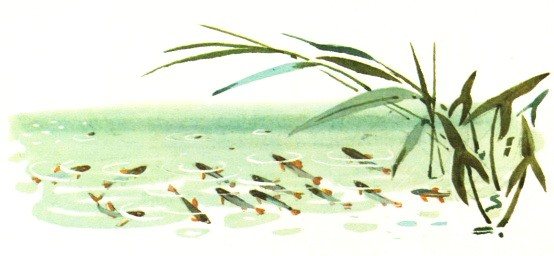
Swimming through a swarm of fry will feel like running through a rain of mushrooms. Everything around sparkles, and light “rains” tickle your body. The fry look into the mask and wag their tails right next to the nose. But catching them is as impossible as catching falling raindrops.
The fry are always very busy. Then they suck leaves - green nipples. Then they hang on their lips from the seaweed - and hang like shiny dewdrops.
The greedy grab mosquitoes from the watery sky, and the curious even stick their noses into our world.
One day a blizzard of moths swept over the water. Light-winged mayflies covered the water with white wings. The fry immediately stuck their noses out of the water. But then suddenly a terrible black shadow flashed over their heads. The fry splashed down in horror.
I surfaced and managed to see a black monster. It was... a swallow! She picked up moths that had fallen on the water.
The little ones have had a lot of fear!
But the fish, like all the guys, don’t like to lose heart. The swallow has flown away - everyone gets down to business at once. Who has his nose to the sky, his tail down; who sucks a leaf; who pulls a moth by the wing.
Gray waves roll across the sky. Wide yellow ribbons of light sway along the bottom.
Balls of air roll between the waves, and fry sway between the yellow ribbons. Shiny like droplets of the sun.
Light and fun underwater!
Knight
No one has ever attacked me in the water. Even big toothy pikes. And suddenly a baby as tall as a finger pounced! Its body is protected by wide shiny plates. Like a knight clad in armor. There is a trident on the hump - three spines. There are two more on the chest, like two daggers.
The knight menacingly spread out all his five thorns and fearlessly stood in my way. He just turned completely dark with anger, and his eyes turned green with anger.
The knight was brave and handsome. His back was blue, his sides were silver, and his cheeks were crimson.
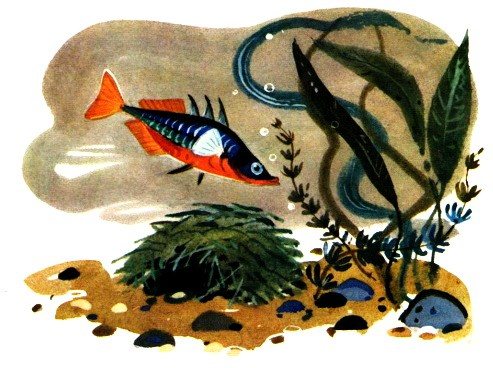
I extended my finger towards him. He rushed forward, poked his finger with a trident, and blood flowed upward from his finger in a viscous stream.
I backed away, kicking up clouds of silt with my flippers. He quickly hid behind a bush of fluffy hornwort and began to watch.
And then the secret of the brave little knight was revealed to me: it turns out that he was guarding his house!
His house was the size of a fist and looked like a fist, loosely clenched: on one side there was an entrance, on the other there was an exit. And there was caviar in the house.
No one could approach his house with impunity. Threatening its thorns, it even attacked large fish. Here a leech floated over the house, wriggling like a black ribbon. The knight turned all purple, grabbed the leech with his teeth and began to torment it, like a dog tormenting a rat. He grabbed the water scorpion by the claw, dragged it under a wide leaf of a water lily and spat it out there.
Not for a moment did he forget about his enemies. Even a passing leaf and a moving shadow drove him crazy. He immediately “changed in his face”, his eyes turned green, and red spots appeared on his cheekbones. Even the white belly was red with anger.
You could immediately tell his mood by the color of his belly.
The armor shone: the knight was ready to fight both with a tiny smooth bug and with a giant man.
Who would have thought that even a simple stickleback becomes a knight if its home is threatened!
Father stickleback guarded his house.

The father stickleback is a very caring fish - not like the mother stickleback. The mother stickleback will lay eggs - and remember her name. And the stickleback dad guards the eggs. And then she grazes her restless stickleback babies. He grabs the most lively and disobedient ones, running away from home, with his mouth, drags them back and spits them right out the door.
They say that if you destroy a stickleback’s house, the father stickleback turns pale from grief and completely loses its bright fighting coloring. And he even stops eating.
I didn’t want such a beautiful and lively fish to become pale and boring. I got out of the hornwort bush and swam away from the fish house.
Text of the book “Tell children about sea creatures”
Larisa Burmistrova, Victor Moroz Tell children about sea creatures
SHARK
Here the doodle shark opened its evil mouth. Would you like to go to the doodle shark Right in the mouth. (K. Chukovsky)
Sharks are powerful predators and are often called “sea wolves.” The body of sharks is ideally suited for fast swimming. When creating high-speed torpedoes and submarines, shipbuilders strive to give them the outline of a shark.
The shark had pain in
several of its teeth at once. Help her quickly, Call the doctors! (N. Migunova)
Sharks have a lot of sharp teeth. They grow in several rows, are triangular in shape, curved back and jagged at the edges. Their sharpness can be compared to a surgical scalpel. Sharks have no scales, and their skin is so tough that residents of tropical countries use shark skin as a grater or sandpaper.
Many people are sure that sharks are very brave animals, so they fearlessly rush at their prey. In fact, sharks are cowardly and attack only when they are convinced that the victim is defenseless. But, sensing the smell of blood, the shark forgets about the danger. Sharks have such a keen sense of smell that they can smell blood from several kilometers away.
The shark feeds on fish, but also attacks dolphins, seals, turtles, other sharks and even whales.
Don’t look at the fact that the shark has
cheekbones that are invisible from the side, and has three rows of teeth in its mouth - it will eat anyone without difficulty. (Yu. Parfenov)
A hungry shark can attack anything it sees nearby. Various garbage was often found in the stomachs of caught sharks: cans, rags, wreckage of boats, and once even a depth charge was found.
Many sharks are dangerous to humans. These are white and tiger sharks, mocha and hammerhead sharks. They are large in size and can easily bite a person in half.
But the largest of the sharks, the whale shark, reaching a length of 19 meters, is quite peaceful. Unlike its predatory relatives, it feeds on plankton and small fish.
CRAB
The crab played sea football,
He scored a goal with his claw. Everyone was so happy that the team won. (N. Migunova)
Crabs run along the bottom of warm seas and oceans. They have a wide and short body covered with a durable shell. Crabs have five pairs of legs. The front legs are transformed into powerful claws. With the help of claws, crabs cut their food into pieces and put it into their mouths.
Crabs, like other inhabitants of the seabed, are good scavengers. They eat the rotting remains of marine organisms, clearing the ocean of harmful substances. But sometimes crabs attack underwater plantations where oysters and mussels are bred.
Traveling along the bottom, crabs are forced to hide from predators and camouflage themselves. They attach pieces of algae to the spines on their legs. And the junk crab, which lives in the Mediterranean Sea, collects everything that comes into its claws - empty shells, broken glass, fish heads - and puts it on its back. Such “scenery” perfectly camouflages the crab. When a junk crab is threatened, it exposes its back with junk to the predator.
The wandering crab once deceived even Christopher Columbus himself. This type of crab does not live at the bottom, but travels along the surface of the ocean, sitting on a detached algae or tree branch. When Columbus approached the shores of America, sailors noticed a wandering crab in the Sargasso Sea. They decided that there was land somewhere nearby, but in fact the nearest shore was still very far away.
The king crab is similar in appearance to a real crab, but is actually a relative of the hermit crab. It has not five, but four pairs of legs. Kamchatka crab is a real giant! The width of its shell reaches 25 centimeters, the distance between the ends of its legs is up to 1.5 meters. Kamchatka crabs live in the Seas of Japan, Okhotsk and Bering Seas. Most of them are off the coast of Kamchatka.
PATTER
The crab made a rake for the crab,
The crab gave the rake to the crab. Hay rake, crab, rake.
MYSTERY
He deftly collects garbage and
cleans the bottom of the sea. (Crab)
CANCER HERMIT
Crayfish climbed the mountain
and learned to whistle. It only turned out to be a BREAK! Cancer fell from the mountain. (I. Zhukov)
In a hermit crab, only the front part of the body is covered with a hard shell, and the abdomen is soft and defenseless. To protect themselves from sea predators, these animals hide in empty sea snail shells, like hermits in caves. The soft abdomen can curl into the curls of the shell, and the abdominal legs quickly pull the body inward.
When moving, crayfish carry the shell with them all the time. When they are in danger, hermit crabs climb entirely into the shell, closing the entrance with a large claw.
When a hermit crab grows up, the old shell becomes too small for it. He gets out of it and looks for a larger sink. At this time, he needs to be especially careful so as not to get eaten by predatory fish.
To enhance protection, the hermit crab often places a sea anemone on its shell. This beautiful ocean dweller, like a bright flower, has very burning tentacles. If you touch them, you can get seriously burned. A hermit crab, having encountered an anemone it likes at the bottom, uses its claw to “pluck” it from the stone and transplants it onto its shell. Anemone is not at all against such a neighborhood - after all, she always gets crumbs from the hermit crab’s dinner table. When a cancer exchanges an old shell for another, it also transplants its burning neighbor to a new home.
Very often, hermit crabs engage in real battles with their relatives for the possession of a shell or a beautiful sea anemone. The defeated cancer lies on its side or back, and the winner does not touch it anymore.
PUZZLES
People live under water and
walk backwards. (Crayfish)
Not a blacksmith,
but with tongs. (Cancer hermit)
OCTOPUS
He lives at the very bottom,
At a terrible depth
-
Many-armed, Many-legged, Legged, Armed. Sprut Kalmarych Octopus goes to sea without boots (G. Kruzhkov)
Octopuses do not have a hard skeleton. Its soft body has no bones and can bend freely in different directions. The octopus was named so because eight limbs extend from its short body. They have two rows of large suction cups, which the octopus can use to hold prey or attach to rocks at the bottom.
Octopuses live near the bottom, hiding in crevices between rocks or in underwater caves. They have the ability to change color very quickly and become the same color as the ground.
The only hard part of an octopus's body is its horny beak-like jaws. Octopuses are true predators. At night they get out of their hiding places and go hunting. Octopuses can not only swim, but also move along the bottom by rearranging their tentacles. The usual prey of octopuses are shrimp, lobsters, crabs and fish, which they paralyze with poison from the salivary glands. With their beak they can break even the strong shells of crabs and crayfish or shells of mollusks. Octopuses take their prey to a shelter, where they slowly eat it. Among octopuses there are very poisonous ones, the bite of which can be fatal even to humans.
Octopuses often build shelters from stones or shells, using their tentacles like hands. Octopuses guard their home and can easily find it even if they have gone far away.
For a long time, people have been afraid of octopuses (octopuses, as they called them), writing terrible legends about them. The ancient Roman scientist Pliny the Elder talked about a giant octopus - polypus, which stole fishing catches. Every night the octopus climbed onto the shore and ate the fish lying in the baskets. The dogs, smelling the octopus, started barking. The fishermen who came running saw the octopus defending itself from the dogs with its huge tentacles. The fishermen had difficulty coping with the octopus. When the giant was measured, it turned out that its tentacles reached a length of 10 meters, and its weight was about 300 kilograms.
MYSTERY
Don't you know me?
I live at the bottom of the sea, Head and eight legs
-
That’s all I am - ... (octopus).
STARFISH
A star fell from the sky and
ended up in the ocean. And now there all year round Slowly crawling along the bottom. (V. Moroz)
The starfish is a predator that lives on the ocean floor. Typically these animals are shaped like a star with five rays. Brightly colored sea stars crawl slowly along the bottom or burrow into the mud. They feed on mollusks, sea cucumbers, brittle stars and sea urchins. The starfish's mouth is located on the underside of its body, so in order to eat its prey, the starfish crawls on top of it.
Starfish have the amazing ability to open the shells of oysters or mussels with their strong rays. Some stars don't even need to open their shells completely. They turn their stomach inside out through their mouth and push it into the hole in the shell. The shellfish is digested right in the shell. Having digested the prey, the star retracts its stomach.
In case of danger, starfish, like lizards, can throw away part of their body. But a new lizard will not grow from a discarded tail. In a starfish, on the contrary, a new animal grows from any part of its body. Scientists conducted experiments - they cut a starfish into several parts. After some time, each part turned into a starfish.
Starfish are relatives of sea urchins. The starfish Asterias even has a calcareous skeleton, and small needles stick out from under the skin. Another species of starfish, accancasters, are similar to sea urchins - their arms and backs are covered with long and poisonous spines. Accancasters cause great damage to coral colonies by eating them.
Some starfish feed on their relatives. For example, crossasters. These huge starfish have 12 arms and grow to almost half a meter in diameter. They are able to move quickly along the bottom and catch up with slower starfish. Crossasters themselves may feel safe because they have poisonous bodies.
SEA URCHIN
Like a cactus on a window,
a sea urchin grows at the bottom. A flounder swam by and poured some water on him. (Yu. Parfenov)
It turns out that hedgehogs live not only on land. There are also sea urchins. They are not relatives of land urchins, but belong to the class of invertebrate animals such as echinoderms.
The outside of the sea urchin's body is covered with a shell from which numerous spines protrude. The needles are very thin and sharp, with serrations at their ends. If such a needle sticks into a person’s skin, it is very difficult to remove it. Sea urchins are poisonous, and if injected, a person will feel a burning pain.
With the help of needles, sea urchins not only protect themselves from enemies, but also move, as if on stilts, along the seabed. The spear-bearing sea urchin moves at high speed, one might even say that it does not walk, but runs.
Small fish use sea urchin spines for protection. They make themselves a safe hiding place between the needles. In gratitude for the fact that the hedgehog protects them, the fish clean its shell. These fish acquire the same color as the color of their “host” - the sea urchin. At night, the fish leave their shelter for a short time, and in case of danger they hide again between the needles.
Despite their terrifying appearance, sea urchins are often defenseless. Their main enemy is starfish. They can stick their stomach between the needles and digest the hedgehog from the outside.
Large snails living in the Mediterranean Sea have invented an unusual way of hunting sea urchins. They spit on their prey! The saliva of these snails contains hydrochloric acid, which paralyzes the hedgehog and corrodes its shell.
Some predatory fish release a strong stream of water from their mouths at the hedgehog. The sea urchin turns over with its unprotected belly up and becomes easy prey.
MYSTERY
It looks like a spiky ball,
lives deep at the bottom. (Sea urchin)
JELLYFISH
A transparent jellyfish
is swimming quietly. If you touch a jellyfish
,
it will burn you like an electric shock! (N. Migunova)
Jellyfish are close relatives of sea anemones and corals. Unlike these animals, they do not spend their entire lives attached to rocks, but rather swim freely in the sea.
Jellyfish have a translucent, umbrella- or bell-shaped body, similar to jelly. These animals swim by rhythmically contracting their umbrella and pushing water out from under it. They capture prey using tentacles.
The tentacles of jellyfish contain stinging cells that can burn the enemy or even paralyze him. The venom contained in the stinging cells of the small cross jellyfish can cause fatal burns in humans.
Another jellyfish, the sea wasp, is also dangerous to humans. It looks like an inverted deep bowl, from which twenty tentacles 10 meters long stretch down. They contain large amounts of poison.
Jellyfish feed on plankton, small crustaceans and fish.
Jellyfish come in different sizes, from a few millimeters to several meters. The largest jellyfish lives in the northern seas - the polar jellyfish. The length of its tentacles reaches 30 meters, and the diameter is two meters.
composes poems about the sea But only about this No one will know, Neither her hands, To hold a pen, nor her mouth, To read out loud. The jellyfish composes for herself, Her silent muse is sad. (I. Zhukov)
Jellyfish live not only on the surface of the ocean, but also in the depths of the sea. Deep-sea jellyfish can glow in the dark. Small crustaceans swim into the light of this living lantern, right into the tentacles of the insidious jellyfish.
Other jellyfish are also glowing. The umbrella and tentacles of the pelagia jellyfish glow with a yellow-orange light. If many Equiorian jellyfish living off the Pacific coast of America rise to the surface, it seems that the whole sea is burning with red fire.
FLYING FISH
In tropical seas live fish that have learned to “fly”. These are representatives of the flying fish family. The front fins of these fish have developed into real wings. Before flying, flying fish first accelerate in the sea to a speed of 40 kilometers per hour, pressing their fins tightly to their body. Then the fish spread their fins wide and suddenly jump out of the water. They hit the water with their tail to increase their speed. Flying fish take off above the water and escape from the predators pursuing them.
Coloring also helps flying fish hide from enemies. Their backs are dark blue, and birds of prey cannot see them from above. The lower part of the body of flying fish is silvery; other fish, swimming from below, also do not see them.
In flight, fish do not flap their fins like birds, but simply glide over the water. Thus, flying fish fly distances from 10 to 300 meters.
There have been cases when flying fish even flew onto the decks of ocean ships. At night, they did not notice the high side of the ship, and the flow of air carried them straight onto the deck.
South America is home to small fish from the characin family, which also fly over the water surface. But at the same time they also wave their fins! Even the sabrefish, a fish living in Russian reservoirs, can jump out of the water, flapping its front fins like wings. These are amazing fish that can’t get enough of moving in the water; they want to master the ocean of air.
PUZZLES
She lives in the water,
There is no beak, but she pecks. (Fish)
Parents and children have
all their clothes made of coins. (Fish)
Shines in the river with a clean
silvery back. (Fish)
SEA TURTLE
A shell protruding from the water plays with gold gloss What kind of animal or bird is this? Without a doubt, a turtle. (N. Kindness)
Sea turtles live in the waters of tropical seas. They are fully adapted for life in an aquatic environment. Their paws turned into flippers, and their shell became streamlined and flattened. Unlike land turtles, sea turtles cannot hide their heads under their shells. The largest sea turtles are leatherbacks. Their length reaches two meters, and their weight is 600 kilograms.
Among sea turtles there are predators that feed on mollusks and crustaceans, and peaceful herbivores that eat aquatic plants, mainly seaweed.
Sea turtles breed on land. They lay large eggs on the sandy shores of islands and continental coasts in the tropics. Helping itself with flippers and even its tail, the turtle crawls several meters from the water. With her hind paws she carefully digs a deep hole in which she lays her eggs. Then the turtle fills the hole and carefully levels it so that the clutch of eggs is not discovered by predatory animals and birds.
The turtles, having hatched from the eggs, obeying instinct, crawl to the water's edge. For their first journey, they choose night time, when it is safer to crawl. And still, out of every ten newborn turtles, only one will be able to reach the sea. Birds with sharp beaks and large crabs with strong claws lie in wait for them.
The turtle is in no hurry,
lying on the waves of the sea. Quietly rows with its fins And swims and floats.
Sea turtles travel long distances in search of food. And in order to lay eggs, they always return to the same beaches. Sometimes these beaches are located many thousands of kilometers from their feeding grounds. Scientists believe that turtles can navigate by smell and the sun along the way.
MYSTERY
Who is at sea
in a stone shirt? In a stone shirt In the sea... (turtles)
WHALE
A whale spends its entire life in water,
even though it is not a fish. He eats in the sea and sleeps in the sea, For which we thank him: It would be cramped on land from the huge carcass! (B. Zakhoder)
The largest animals on our planet are whales. The largest of them, blue whales, reach a length of 30 meters and a weight of 150 tons.
The ancestors of whales once lived on land, but then returned to the sea. The animals' bodies acquired a streamlined shape, and their fur disappeared.
Fountains are flowing in the ocean,
A whale is swimming towards us. How huge it is - Like a house or a steamship. (N. Migunova)
Whales look like huge fish, but they are not fish, but mammals, and their internal structure is almost the same as that of a person. And whales, like other mammals, feed their young with milk. Whales are warm-blooded animals, and they are protected from hypothermia by a thick layer of subcutaneous fat.
The nostrils of whales are located on the top of the head. They open only for a short moment of inhalation and exhalation, when the whale floats to the surface of the water. Whale lungs have a large volume, and whales can stay under water for a long time without breathing, and even dive to a depth of more than 500 meters, and sperm whales - to a depth of more than one kilometer.
Adults and children know -
I am bigger than anyone in the world! Two miles from the ship you can see me!
To navigate in the water, whales make sounds that the human ear cannot detect. The whale's brain is a real sonar that picks up sound signals reflected from various objects in the water and determines the distance to them.
Whales feed mainly on fish or small crustaceans. They swim with their mouths open, filtering water through special plates called whalebone.
Some whales, called odontocetes, do not have baleen, but do have teeth. Toothed whales, sperm whales, feed on huge squids, in search of which they dive to great depths.
People have been hunting whales for a long time. Nowadays, there are few of these giants left, and they are taken under protection.
MYSTERY
A miracle giant swims across the sea-ocean and hides his mustache in his mouth. (Whale)
DOLPHIN
Dolphins show their backs to us from the sea water
. How beautifully they swim
-
Very quickly and playfully! (N. Migunova)
One beautiful legend says that dolphins are people who once went to sea, and therefore people and dolphins have a lot in common. Indeed, dolphins are the most intelligent inhabitants of the ocean. They treat people in a special way. Dolphins often saved drowning sailors by holding them on the surface of the water with their bodies.
One day, when the ship was wrecked, there were many people in the water. Dolphins quickly swam to their rescue. They swam around and drove hungry sharks away from people until a rescue ship arrived.
Dolphins often swim close to the shore to play with people. And one Scottish girl even made friends with a dolphin, and he swam to her house on the ocean every day.
Forgetting about their own safety, dolphins are ready to help other animals. It happened that dolphins even helped wounded sharks, and sharks are the worst enemies of dolphins.
Dolphins are easily tamed by humans. Numerous dolphinariums have been created, where trainers teach them various circus tricks. There are such dolphinariums in our country.
Bottlenose dolphins are considered the most capable. Sometimes they show even greater intelligence than trained monkeys. Dolphins are good at imitating human sounds, such as laughing or crying. They can even repeat individual words and entire sentences.
wanders over the sea
. In the morning a little boy goes out to the sea. The boy whistles loudly - swims quickly out of the depths of the sea . Sparkling with splashes, he will emerge towards him, exposing his back to his friend. (S. Baranov)
Dolphins have their own language of communication. They “talk” to each other, making whistling and clicking noises. When chasing prey, dolphins make sounds similar to a dog barking; when they are fed, they “meow,” and when unfamiliar objects appear nearby, the dolphin’s voice is similar to the creaking of rusty door hinges.
blue crayfish
Everyone knows that cancer is red. They even say: “Red as a lobster!” But cancer only turns red in boiling water. Live crayfish is brown in color. Everyone knows this too.
But does anyone know that among common crayfish there are blue ones?
One summer I caught one of these in the Gryaznaya River. Everything about him is like a brown crayfish: claws, eyes on stalks, a crayfish neck. And the color is blue!
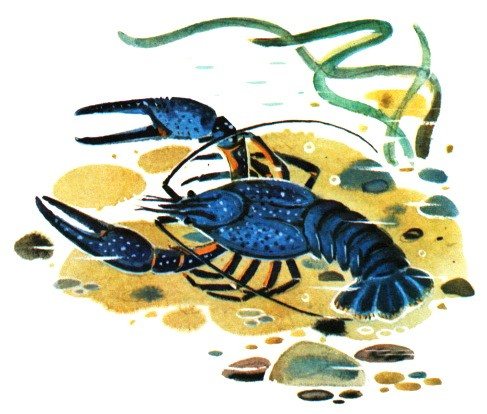
The shells of common crayfish always match the color of the dark bottom, but this one is blue, like the spring sky. And what if it goes into boiling water, what will it become then? It would be nice to cook it. Crayfish eaters say that in those months in which there is no letter “r” - in the summer - crayfish are especially tasty!
Still, I didn’t cook the blue crayfish; I regretted it. Threw it back into the river. After all, maybe it’s cancer for all cancers. Maybe the whole breed of crustaceans will change from him. Maybe they won’t hide in dark holes like water rats, and won’t back away. Maybe they will rise from the dark bottom to the underwater sky and live among bright and beautiful fish. And maybe everyone will then call our Dirty River the Blue Crayfish River!
So here it is: not all crayfish are brown.
There are also blue ones.
Let it be known to you too!
Fish dances
Before sunrise, a purple cloud with a fiery rim hung over the horizon. The sun rose crimson, and everything - the earth and the sky - turned red. I am sitting under a willow bush with narrow red leaves. Ducks are whistling their wings overhead, and their wings are pink.
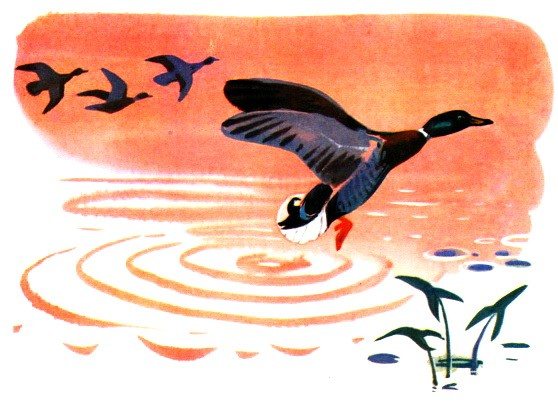
An extraordinary sunrise!
Red waves are crushed in the red river. Scarlet clouds of steam move above the wave.
Black seagulls screaming and rushing overhead, like a black crow above the glow of a fire. As if burned, they twist their wings and fall into the burning river, splashing out sheaves of sparks.
The seagulls are getting closer, their cries are getting louder.
And suddenly black fish began to jump out of the red waves. Narrow, like willow leaves. They fly out standing up and, standing up, tail down, fall into the red water. A whole joint flew out and scattered like a fan. Here it is again: one by one, one by one.
Fish dancing!
I look with all my eyes.
Could it be that the fish’s blood also flared up on this amazing red morning?
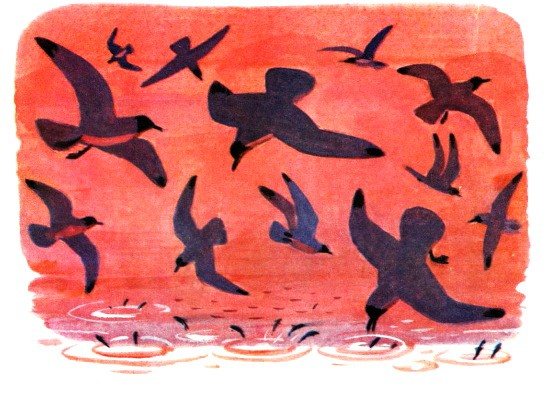
And in the middle of the river, in the commotion of the waves, two black specks are moving: a smaller speck and a larger speck. A flat head and a hump-like back stick out from the water. Otter! She dived as if she had melted, and fish immediately jumped out of the water and danced: up and down, up and down!
The seagulls saw it and fell, breaking their wings. They began to catch fish right on the fly.
Everything immediately became normal.
The sun rose, and the black seagulls turned white, the black fish turned silver, the red water turned gray. The purple cloud on the horizon moved and melted.
The predators—gulls and an otter—followed the dancing fish and disappeared around a bend in the river.
And I lay by the snag and wrote down what I saw. He started writing on a red piece of paper and ended up writing on a gold one.
Corals
A more accurate name for such well-known organisms as corals is “coral polyps.” What we used to think of as coral is actually the skeleton of a coral polyp. The coral polyp is very small in size, its shape is not as picturesque as the shape of its skeleton, but rather resembles a grain of rice. The coral polyp does not have a backbone, but it does have tentacles.
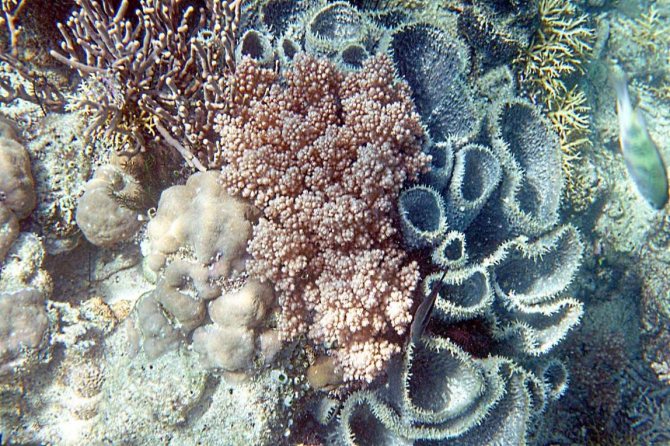
Coral polyps are used in the jewelry industry.
After the death of a polyp, its skeleton (otherwise called a “corallite”), connecting with others, creates a coral reef. New polyps develop directly on the skeletons of old ones, significantly changing the topography of the seabed.
The coral reefs are incredibly beautiful and very attractive to scuba diving enthusiasts. Corals are different. Coral reefs consist mainly of stony corals. There are also soft corals and horn corals (their scientific name is gorgonians). All corals have in common a love for tropical climates and high water temperatures. For example, the Black Sea is not warm enough for these creatures.
Today we know at least five hundred varieties of corals. Almost all of them prefer to live at shallow depths.
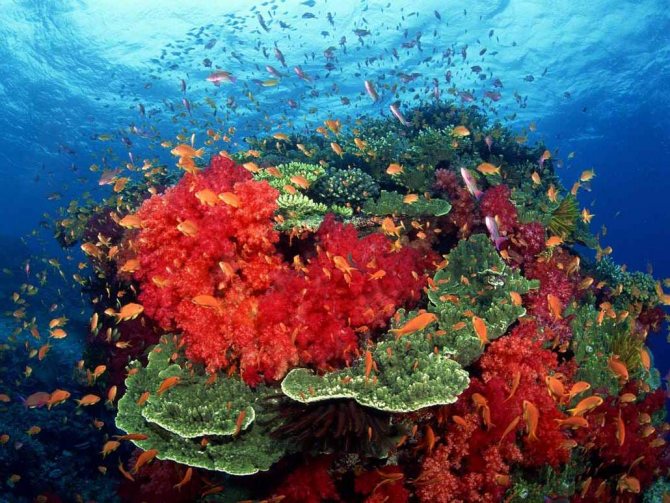
Corals primarily live in warm ocean and sea waters.
A coral polyp without its strong calcareous skeleton is very fragile. They live on the bottom or resemble a bush or tree in shape. Their colors are varied and very intricate. Coral can grow to significant sizes - from one and a half to two meters. Corals are inhabitants of the seas and oceans. Fresh water is harmful to them.
Corals need sunlight to function normally. These organisms breathe with the help of tiny algae that live directly in the tissues of the polyp's body.
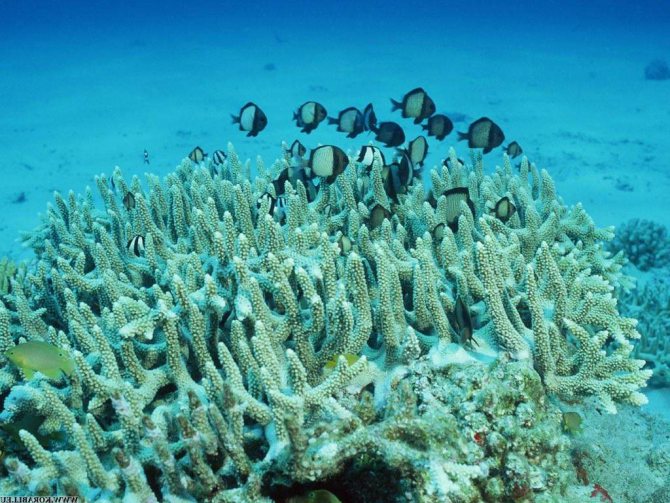
Corals feed on plankton, which they capture with their tentacles.
Corals eat plankton as food. It sticks to their tentacles, which then send food into their mouths. The mouth is located under the tentacles.
Sometimes, due to tectonic processes, the ocean floor is no longer hidden by water. In this case, the coral reef that comes up becomes the basis for a new island.
Over time, it develops its own flora and fauna, and then people settle on this island. This is how some of the inhabited islands of Oceania arose.
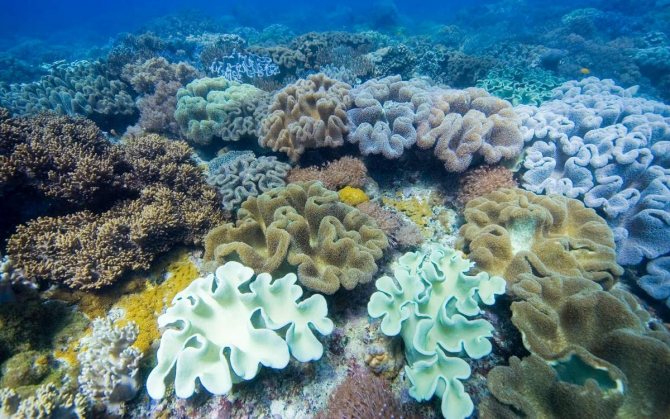
Corals are usually called only the skeleton of the colony, which remains after the death of many small polyps.
Autumn underwater
You swim and undress, and I swim and get dressed. I put on warm underwear, warm trousers and a warm jacket. I put woolen socks on my feet and woolen gloves on my hands.
On top of everything is a rubber suit.
Mask on your face, fins on your feet, and into the water.
You swim in the summer, and I swim in late autumn. I look at how autumn is under water.
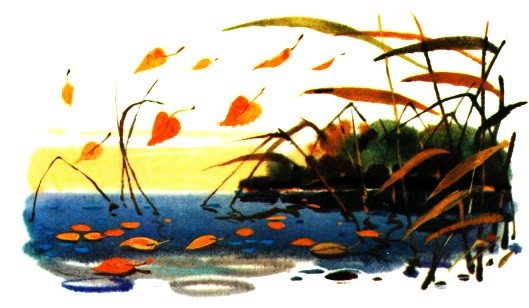
It's cold in the autumn in the underwater forest. A furious wind drives angry waves above. Yellow reeds bend over the water, as if looking into the depths.
And deep down everything is in motion. Drowned leaves squirm along the bottom. Mossy reeds sway. The swollen driftwood logs roll from side to side like piglets.
There is a high blue sky above the lake. There are burning candles on the banks of the birch tree. Black strict spruces. Trembling red aspen trees. Gold autumn.
But in the underwater forest there is no golden autumn. Autumn under water is always gloomy. Your face is freezing from the water. The leaves don't rustle, the wind doesn't whistle. The surrounding area is deserted and deaf.
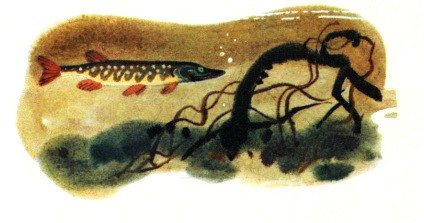
The algae branches broke, drooped, and drooped. Everything faded and became covered with a thick layer of turbidity.
The fast shiny fish don't play. The fish sank into the dark depths. The frogs huddled together and buried themselves in the thick mud. Some green-eyed pike quickly leave, raising mud with their tails. Long thin algae move like lazy sleepy snakes...
The earth will soon be covered with snow - a white winter will come. And the water will be covered with ice. And under the water there will come a long night - a black winter. Both on land and under water, everyone will eagerly await the arrival of green spring.
